Is LIGO About To Destroy The Theory Of A ‘Mass Gap’ Between Neutron Stars And Black Holes?
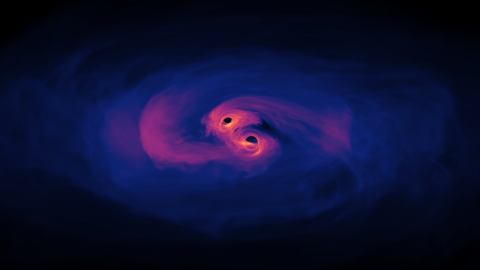
What’s more massive than the heaviest known neutron star but lighter than the lightest known black hole? LIGO may be about to solve that mystery.
Whenever a star is born in the Universe, its eventual fate is almost completely determined from the moment nuclear fusion ignites in its core. Dependent only on a few factors — mass, the presence of elements heavier than helium, and whether it’s part of a multi-star system — we can calculate with dramatic accuracy what the eventual fate of a star born with specific properties will be.
For most stars, including all the stars similar to our Sun, the eventual fate will be a white dwarf: an extremely dense collection of atoms more massive than dozens (or even hundreds) of Jupiters, but only the size of planet Earth. For more massive stars, though, a more catastrophic fate awaits: a supernova, which could either give rise to a neutron star or black hole remnant. There may or may not be a mass gap between the heaviest neutron stars and the lightest black holes formed by supernova, and humanity’s never been in a better position to find out.
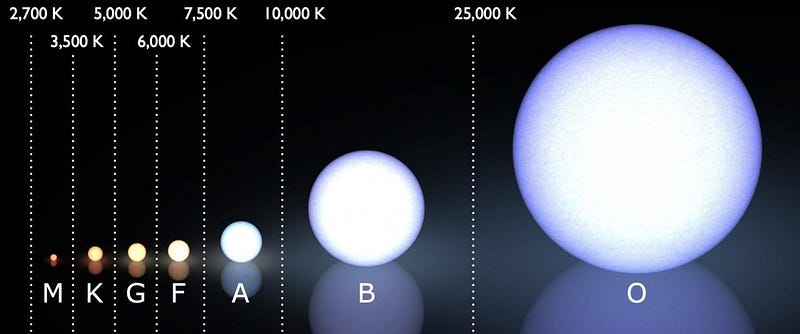
The more massive a star is, the more material it has that’s potentially usable as fuel for nuclear fusion. You might be inclined to think that with more fuel to burn, the more massive stars would live longer, but the exact opposite turns out to be true.
The way you form stars is via the collapse of a molecular cloud of gas. When you have more massive amounts of matter that go into forming your star, the collapse of that cloud traps greater amounts of heat inside, leading to greater core temperatures over a greater volume of space inside that star. Although achieving a temperature of 4,000,000 K (or so) inside a star’s interior is enough to ignite nuclear fusion, greater temperatures lead to significantly faster rates of fusion, which equate to more luminous but shorter-lived stars.
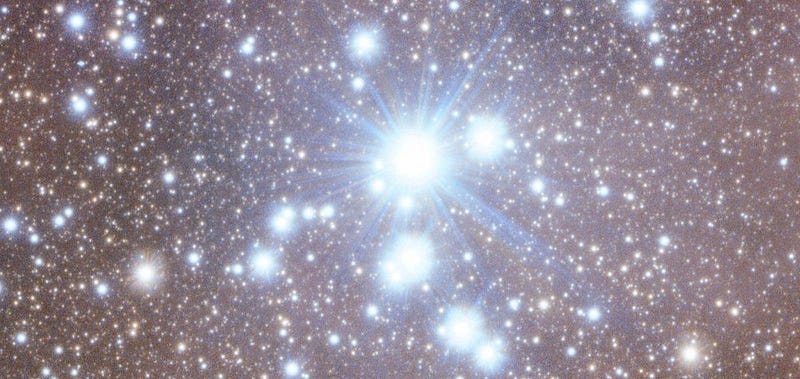
At the extreme high-mass end of the spectrum, stars can achieve temperatures of many tens or even hundreds of millions of Kelvin. When the abundance of hydrogen in the inner core drops below a critical threshold, the rate of fusion in the core begins to decrease, which means the outward pressure generated in the star’s core also begins to drop. Since that was the primary force that counteracts all the gravitation working to collapse the star, running low on fuel implies that the star’s core will begin to contract.
Whenever you have a large amount of matter that contracts rapidly (i.e., adiabatically), the temperature of that system will increase. For massive-enough stars, the contraction of the core will heat it sufficiently that it can start fusing additional elements. Beyond hydrogen fusion, helium can fuse into carbon. For stars more massive than about 8 times our Sun’s mass, they’ll go beyond that and fuse carbon, oxygen, neon, silicon, etc., until the inner core consists of elements like iron, nickel and cobalt: nuclei that can be fused no further.
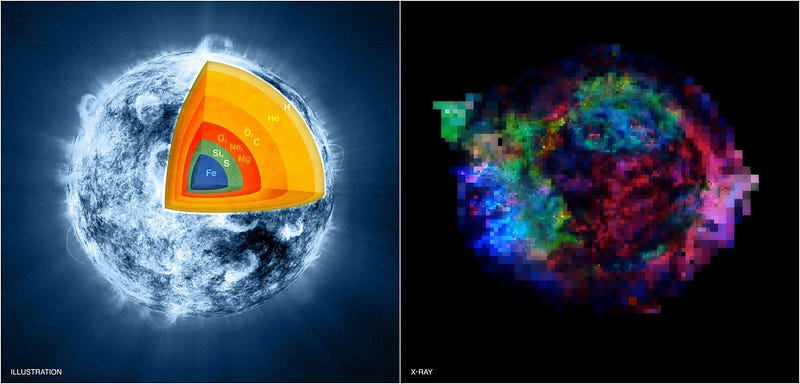
Once you begin creating iron, nickel and cobalt in your star’s core, there’s nowhere left to go. Fusing these nuclei into even heavier elements requires more energy than the fusion process puts out, meaning that it’s more energetically favorable for the core to collapse than it is for new fusion reactions to occur. When the core collapses, a runaway fusion reaction occurs, blasting apart the star’s outer layers in a supernova explosion, while the core collapses down, imploding.
The cores of stars that are on the lower-mass end of the supernova spectrum will produce neutron stars at their centers: stellar remnants that are like one giant atomic nucleus a few dozen kilometers across, but containing up to approximately ~2.5 solar masses of material. On the high-mass end, however, black holes are produced, of approximately 8 solar masses and above.
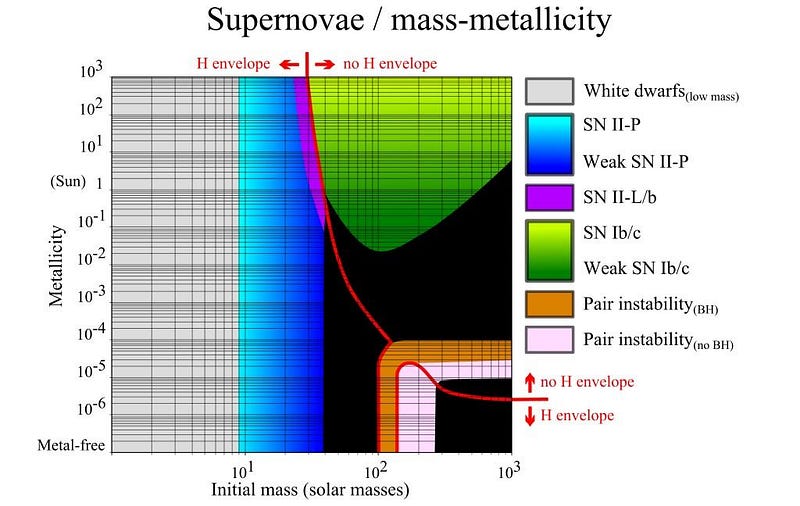
Although we have a variety of methods for inferring the masses of neutron stars and black holes, the simplest way is to find one of these stellar remnants that’s in a binary orbit with another detectable massive object. Neutron stars pulse, for example, and observing the behavior of a pulsing neutron star that orbits another neutron star enables you to determine the mass of both.
Neutron stars that glitch as they rotate, burst, or orbit in systems with other stars, can similarly have their masses inferred. Mass is mass and gravity is gravity, and those rules do not change, no matter what your mass is made of. For black holes, on the other hand, we were only able to infer the masses of the smallest ones when they’re part of X-ray binary systems. For nearly a decade, a puzzle has arisen, leading to the idea of a “mass gap” between neutron stars and black holes.
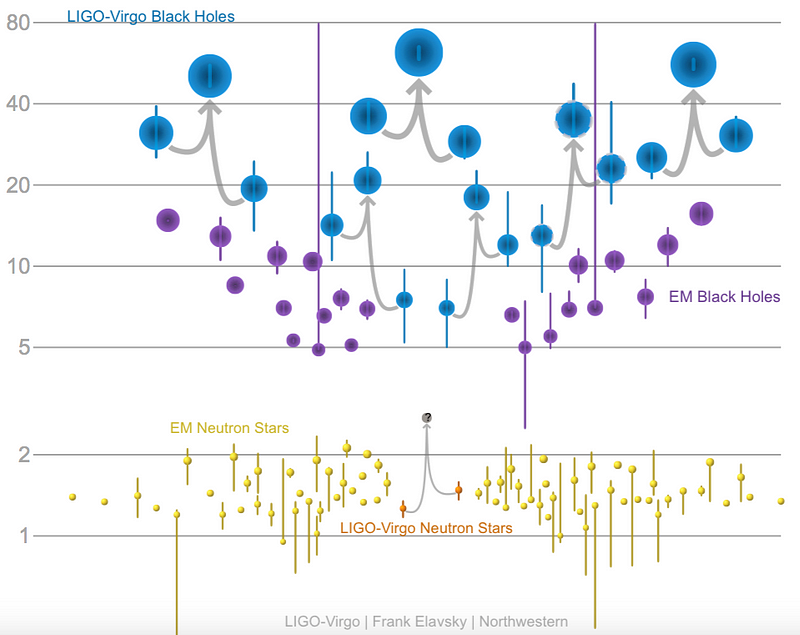
Starting in 2010, scientists who studied these binary systems that contained either neutron stars or black holes noticed something peculiar: while black holes as low as about 7 or 8 solar masses were observed, and neutron stars as massive as approximately 2 solar masses were seen, there was nothing discovered in between. In other words, between low-mass neutron stars and higher-mass black holes, there appeared to be a mass range, perhaps between 2–2.5 and 5–8 solar masses, where neither black holes nor neutron stars appeared to live.
Sure, there’s always the possibility that we’ve made an incorrect assumption about the physics and astrophysics involved, but even those studies that consider it still cannot explain why there’s such a steep drop-off in the number of sources seen below about 5 solar masses.
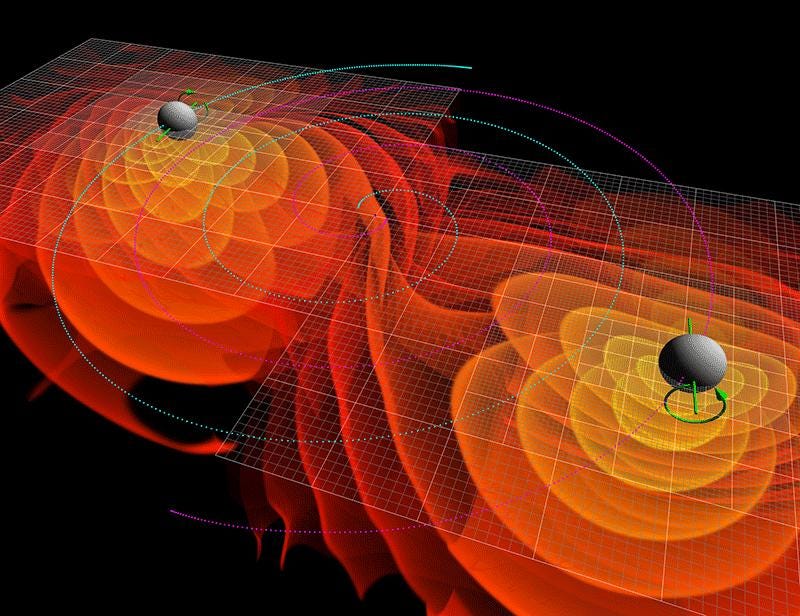
It’s possible that there’s a good astrophysical reason for it. Not every star that’s massive enough to go supernova will do so, as there are other possible fates awaiting such stars. They include:
- gas-stripping from orbiting companions, leaving a degenerate core,
- pair instability supernovae, where internal energies rise high enough that electron-positron pairs are spontaneously produced, resulting in the destruction of the entire massive star,
- mergers with a companion, creating intermediate-mass objects that are relatively rare, or
- direct collapse, as massive-enough stars could experience a cataclysm where the entire star collapses down to a black hole; such a phenomenon was observed for the first time directly just a few years ago.
It may be the case that supernova explosions that create neutron stars are fundamentally different from the ones that create black holes. If so, there may only be a small number of objects of greater mass than common neutron stars but of lower mass than common black holes. It’s possible the only “mass gap” objects result entirely from the mergers of two neutron stars.
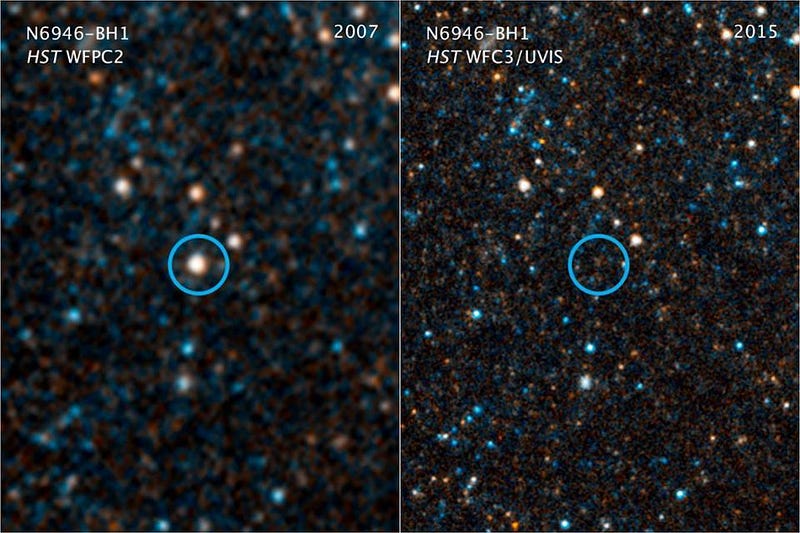
So, is the mass gap real? Or are there plenty of neutron stars and/or black holes in this mass range that appears to be so sparsely populated today?
One possibility that would reveal the answer is to examine the presence of free-floating masses in the galaxy in a source-independent way. That can be accomplished by applying the science of gravitational microlensing: where a mass passes between our line-of-sight and a distant light source, causing a transient brightening-and-dimming of the background source in a fashion that’s dependent only on the mass of the intervening mass.
The most recent microlensing studies take advantage of data from the ESA’s Gaia mission, and find no evidence at all for this purported mass gap. Instead, they have uncovered a number of interesting microlensing candidates with exactly the masses you’d need to fill in this so-called gap.
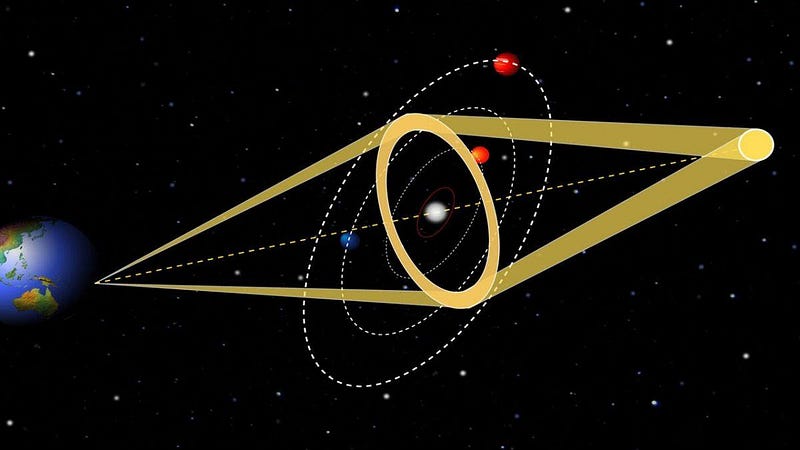
But the studies we’ve mentioned so far — indirect studies such as these — are hardly conclusive. What you’d want is a way to directly measure/infer the masses of objects independent of their nature, while simultaneously being able to determine whether they’re neutron stars, black holes, or something more exotic. At the beginning of the decade, this was a mere dream; a goal that lay far beyond our technical capabilities.
But with the recent successes and upgrades to gravitational wave detectors like LIGO and Virgo, we’re in an incredible position today: one where the coming months and years should reveal whether the mass gap still persists if we look at the Universe in gravitational waves alone. If there’s a smooth, unbroken distribution of the masses of stellar remnants in the Universe, we fully expect that we’ll begin finding these objects that fill the mass gap imminently, as LIGO’s sensitivity range finally begins to include these low-mass objects.
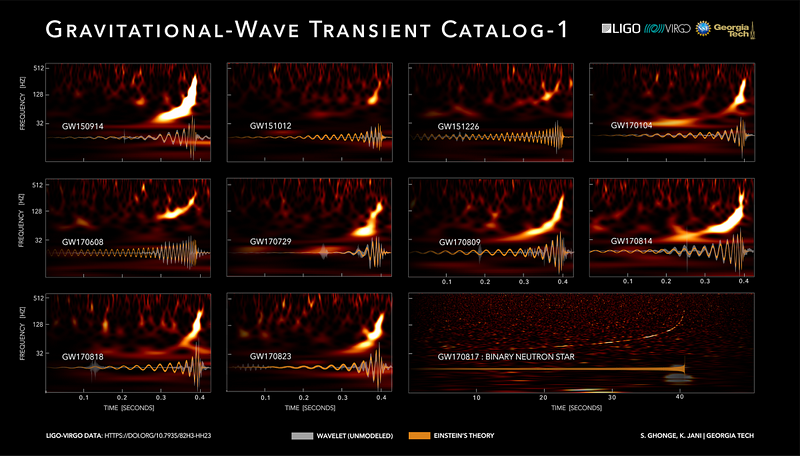
Detecting massive objects like neutron stars and black holes with gravitational waves is a monumental accomplishment, but one that’s limited by the sensitivity of your detector. When they exist in binary systems and spiral into one another, however, they emit gravitational radiation: a signal that a sensitive-enough detector can uncover. For a gravitational wave detector like LIGO, there are four things to consider:
- The more massive your two inspiraling masses are, the greater the amplitude of your signal.
- The closer in space the two masses are to one another, the greater the amplitude of the arriving signal.
- The closer in space the merging masses are to you, the greater the amplitude of the arriving signal.
- And the lower in mass these two masses are, the greater the amount of time they spend in the frequency range detectable by LIGO.
In other words, there’s a trade off: more massive objects are detectable a greater distance away (over a larger spatial volume), but less massive objects spend more time in the frequency range LIGO is sensitive to.

On August 14, 2019, LIGO announced a candidate event that appeared to fall squarely within this “forbidden” mass range. While follow-up analysis likely indicates that this is a neutron star merging with a black hole rather than an object located in the “mass gap” regime, it’s an enormous achievement to realize that LIGO, at long last, now possesses the capability of filling in the gap once and for all.
All in all, LIGO is on its way to picking up these lower-mass objects: the ones that fall in the “mass gap” range. We do not know where the most massive neutron star is, nor where the least massive black hole is. We do not know if merging binary neutron stars always produce black holes when they merge (something we think occurred for the one kilonova observed in 2017), and we do not know if such mergers are the only way that the Universe populates the mass gap region. But with more data from the current run of LIGO and Virgo — and future runs where the sensitivity is even further enhanced — astrophysicists might either confirm or destroy the notion of a mass gap entirely.
Ethan Siegel is the author of Beyond the Galaxy and Treknology. You can pre-order his third book, currently in development: the Encyclopaedia Cosmologica.





